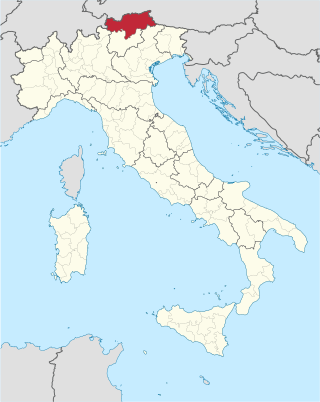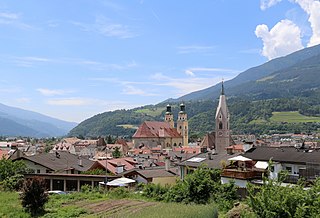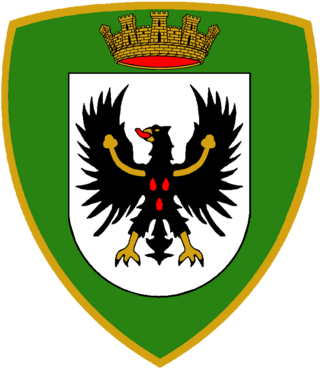
South Tyrol is an autonomous province in northern Italy. An English translation of the official German and Italian names could be the Autonomous Province of Bolzano – South Tyrol, reflecting the multilingualism and different naming conventions in the area. Together with Trentino, South Tyrol forms the autonomous region of Trentino-Alto Adige/Südtirol. The province is the northernmost of Italy, the second largest with an area of 7,400 square kilometres (2,857 sq mi), and has a total population of about 534,000 inhabitants as of 2021. Its capital and largest city is Bolzano.

Brixen is a town and commune in South Tyrol, northern Italy, located about 40 kilometres (25 mi) north of Bolzano.

Lienz is a medieval town in the Austrian state of Tyrol. It is the administrative centre of the Lienz district, which covers all of East Tyrol. The municipality also includes the cadastral subdivision of Patriasdorf.

Franzensfeste is a comune and a village in South Tyrol in northern Italy. It is named after the large Franzensfeste Fortress erected from 1833 to 1838 and Franzensfeste station is also known as an important railway hub.

The Puster Valley is one of the largest longitudinal valleys in the Alps that runs in an east-west direction between Lienz in East Tyrol, Austria, and Mühlbach near Brixen in South Tyrol, Italy. The South Tyrolean municipalities of the Puster Valley constitute the Puster Valley district.

Innichen is a municipality and a village in South Tyrol in northern Italy.

The Alpine Brigade "Tridentina" was a light Infantry brigade of the Italian Army, specializing in mountain warfare. Its core units were Alpini, the mountain infantry corps of the Italian Army, that distinguished itself in combat during World War I and World War II. The Alpine Brigade "Tridentina" carried on the colours and traditions of the WWII 2nd Alpine Division "Tridentina".

Innsbruck Hauptbahnhof is the main railway station in Innsbruck, the capital city of the Austrian federal state of Tyrol. Opened in 1853, the station is a major hub for western and central Austria. In 2019, it was the 8th-busiest station in the country, and the 2nd-busiest outside of Vienna after only Linz Hauptbahnhof, with 315 train movements and 38,500 passengers daily.

The Hochpustertal is the easternmost part of the Puster Valley, stretching from the watershed of the Rienz and Drava rivers at Niederdorf in South Tyrol down the Drava to Lienz in East Tyrol, Austria. The area includes the Sexten and Prags side valleys.

The Brenner Railway is a major line connecting the Austrian and Italian railways from Innsbruck to Verona, climbing up the Wipptal, passing over the Brenner Pass, descending down the Eisacktal to Bolzano/Bozen, then further down the Adige Valley to Rovereto/Rofreit, and along the section of the Adige Valley, called in Italian the "Vallagarina", to Verona. This railway line is part of the Line 1 of Trans-European Transport Networks (TEN-T). It is considered a "fundamental" line by the state railways Ferrovie dello Stato (FS).

The Tyrol S-Bahn, operated by ÖBB, provides regional rail services in metropolitan Innsbruck, Austria and its hinterlands in the state of Tyrol; and extended rail services into Italy and Germany.

Klagenfurt Hauptbahnhof is the main railway station in Klagenfurt, capital of the Austrian state of Carinthia. It is an important railway junction in southern Austria.

Bolzano/Bozen railway station is the main station of Bolzano, capital of the autonomous province of South Tyrol, in northeastern Italy.

Rovereto railway station serves the Comune of Rovereto in the autonomous province of Trentino, northeastern Italy.

Brenner railway station is the border station of Italy and Austria. It serves the town and comune of Brenner in the autonomous province of South Tyrol, northeastern Italy.

Tyrol is a historical region in the Alps of Northern Italy and western Austria. The area was historically the core of the County of Tyrol, part of the Holy Roman Empire, Austrian Empire and Austria-Hungary, from its formation in the 12th century until 1919. In 1919, following World War I and the dissolution of Austria-Hungary, it was divided into two modern administrative parts through the Treaty of Saint-Germain-en-Laye:

The Alpini Battalion "Val Brenta" is an inactive mountain warfare battalion of the Italian Army based last in Bruneck in South Tyrol. The battalion belongs to the Italian Army's Alpini infantry speciality and was assigned to the Alpine Brigade "Tridentina". In 1882, the Royal Italian Army formed the Battalion "Val Brenta", which four years later was renamed Alpini Battalion "Bassano". In 1915, the army formed a new Alpini Battalion "Val Brenta", which fought in World War I in the alpine areas of the Italian front. The battalion was disbanded in 1920. In September 1939, the "Val Brenta" battalion was reformed and in June 1940 the battalion participated in the Italian invasion of France. At the end of October 1940 the battalion was disbanded.

The Drava Valley Railway is an east–west railway running along the Drava. It runs from Maribor to Innichen, where it merges into the Puster Valley Railway to Franzensfeste (Fortezza). It starts in northern Slovenia, crosses Carinthia and East Tyrol and ends in South Tyrol. The Klagenfurt–Bleiburg section has been rebuilt as part of the Koralm Railway, which follows the Jaun Valley Railway (Jauntalbahn) from Bleiburg. Like the rest of the line in Slovenia, this section of the line has one track and is unelectrified.

Franzensfeste station is a railway station located on the Brenner Railway and the western terminus of the Puster Valley Railway. It serves the town of Franzensfeste (Fortezza).

Innichen station is a railway station located in Innichen, Italy where the Puster Valley Railway and the Drava Valley Railway meet in eastern South Tyrol. It is the border station between Italy and Austria.

























